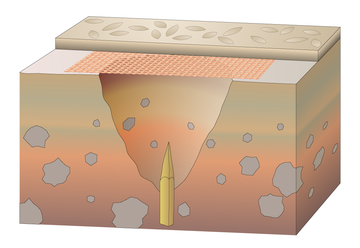
Trou de loup
Encyclopedia

Medieval fortification
Medieval fortification is military methods of Medieval technology that covers the development of fortification construction and use in Europe roughly from the fall of the Western Roman Empire to the Renaissance...
, a trou de loup (French
French language
French is a Romance language spoken as a first language in France, the Romandy region in Switzerland, Wallonia and Brussels in Belgium, Monaco, the regions of Quebec and Acadia in Canada, and by various communities elsewhere. Second-language speakers of French are distributed throughout many parts...
for "wolf hole"; plural trous de loup, also commonly referred to as a tiger pit in the East) was a type of booby trap
Booby trap
A booby trap is a device designed to harm or surprise a person, unknowingly triggered by the presence or actions of the victim. As the word trap implies, they often have some form of bait designed to lure the victim towards it. However, in other cases the device is placed on busy roads or is...
or defensive obstacle. Each trou de loup consisted of a conical
Cone (geometry)
A cone is an n-dimensional geometric shape that tapers smoothly from a base to a point called the apex or vertex. Formally, it is the solid figure formed by the locus of all straight line segments that join the apex to the base...
pit about 2 m (6 ft 6 in) deep and 1.2 to 2 m (3.9 to 6.5 ft) wide at the top. At the bottom of the pit, a sharpened Punji stick
Punji stick
The Punji stick or Punji stake is a type of booby trapped stake. It is a simple spike, made out of wood or bamboo, generally placed upright in the ground. Punji sticks are usually deployed in substantial numbers....
(wooden stake) would be hammered in. In some cases, the pit was concealed by light cover of wicker
Wicker
Wicker is hard woven fiber formed into a rigid material, usually used for baskets or furniture. Wicker is often made of material of plant origin, but plastic fibers are also used....
and a layer of soil.
Trous de loup might be found singly as a trap (in which case they were always concealed), or in a dense pattern with no gaps between pits, used as an obstacle in front of a defended position.
A field of trous de loup could be made most effective if subsequently flooded to a shallow depth, which would conceal the pits, make their sides slippery, and add the risk of drowning
Drowning
Drowning is death from asphyxia due to suffocation caused by water entering the lungs and preventing the absorption of oxygen leading to cerebral hypoxia....
.
Sometimes it includes a mixture of rotting meat, feces, and other infectious agents to the ends of the sticks to cause serious infection and quite often death when it enters the victim's bloodstream when it stabs into their foot.
History
Even though the term has a medieval origin, this kind of device was first described by Julius CaesarJulius Caesar
Gaius Julius Caesar was a Roman general and statesman and a distinguished writer of Latin prose. He played a critical role in the gradual transformation of the Roman Republic into the Roman Empire....
, in the seventh book of his Commentarii de Bello Gallico
Commentarii de Bello Gallico
Commentarii de Bello Gallico is Julius Caesar's firsthand account of the Gallic Wars, written as a third-person narrative. In it Caesar describes the battles and intrigues that took place in the nine years he spent fighting local armies in Gaul that opposed Roman domination.The "Gaul" that Caesar...
(Commentaries on the Gallic Wars), who employed the device during the siege of Alesia
Battle of Alesia
The Battle of Alesia or Siege of Alesia took place in September, 52 BC around the Gallic oppidum of Alesia, a major town centre and hill fort of the Mandubii tribe...
. Caesar calls them lilies for their resemblance to the flower of the same name. Later Roman examples can be seen at Rough Castle on the Antonine Wall
Antonine Wall
The Antonine Wall is a stone and turf fortification built by the Romans across what is now the Central Belt of Scotland, between the Firth of Forth and the Firth of Clyde. Representing the northernmost frontier barrier of the Roman Empire, it spanned approximately 39 miles and was about ten feet ...
in Great Britain
Great Britain
Great Britain or Britain is an island situated to the northwest of Continental Europe. It is the ninth largest island in the world, and the largest European island, as well as the largest of the British Isles...
.

